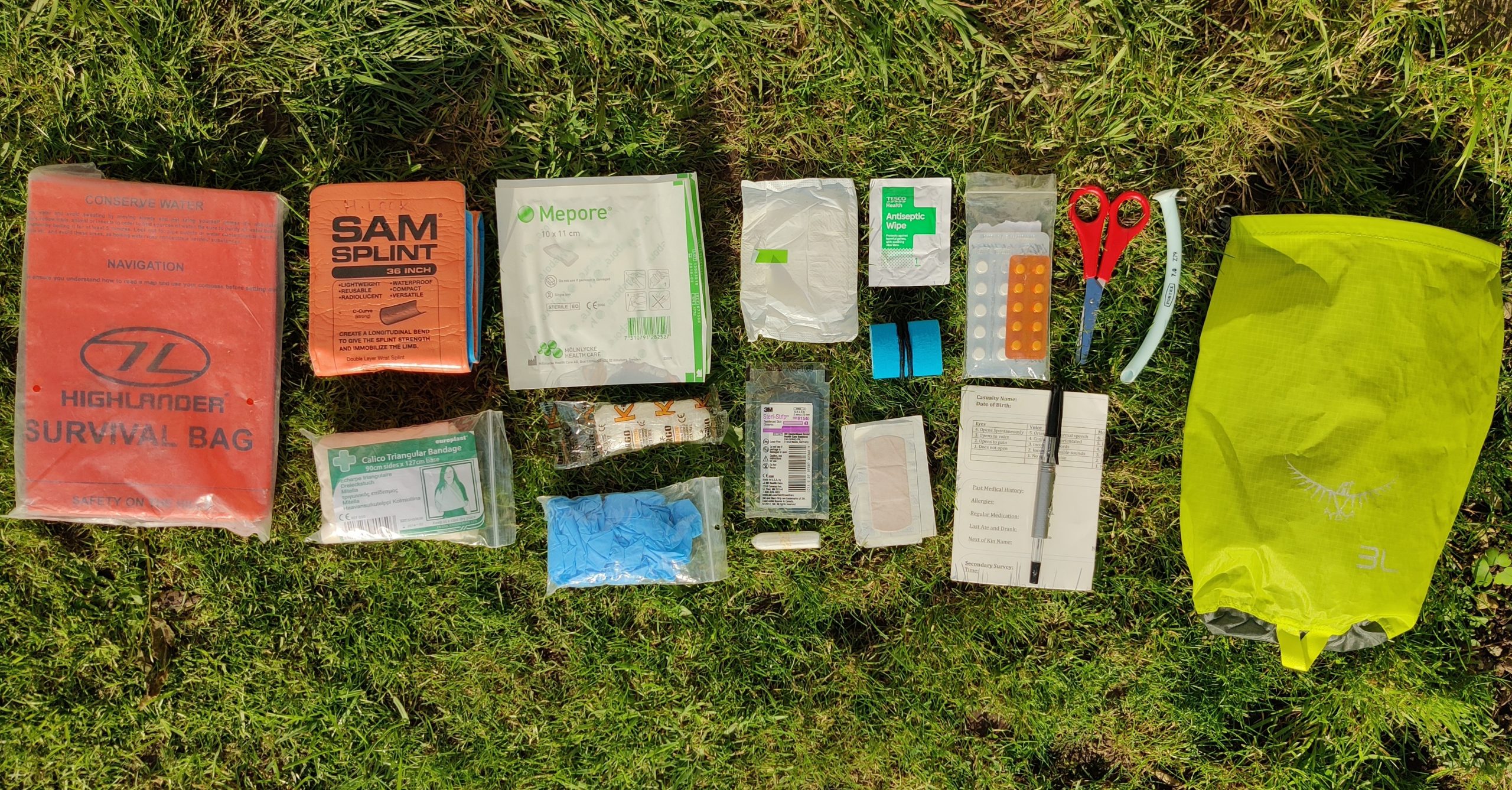I often get asked about what to pack in a mountain first aid kit and I know it can be difficult to know where to start. Lots of companies sell pre-made first aid kits which are usually adequate for most people, but I personally like to tailor my kit to a specific adventure. It is also important to consider your own medical skills and those of the rest of the group. Don’t bother carrying kit you don’t know how to use and those with more advanced medical skills could consider carrying extra items.
When I’m in the mountains with friends I usually take very little in the way of first aid kit (because I have to carry it!) so I want to ensure that the items I do carry are well thought through. I take things that are commonly required and other items that I hope I don’t have to use but that can make a significant difference in an emergency.
Firstly, your mountain first aid kit is not designed to be an entire hospital and pharmacy in your bag, it is designed to be enough to patch someone up to get them to definitive medical treatment (if required), or enough to patch them up so that they can continue with their activity. You can’t carry kit for all eventualities so you have to be logical but creative with your approach. Secondly, minor injuries and illness are the most common medical issues in the mountains so don’t get too concerned about having lots of kit to deal with serious incidents (you’ll need help for that), focus on dealing with common, minor issues where the kit you carry can make the most impact.

Here’s what I consider when deciding what to pack:
- Location
- How remote are you going, is there even an option of a rescue team helping you? If there are rescue services, how much time will they take to reach you and how much time is it to reach a hospital?
- Duration of the trek/climb
- A 1 day low level walk vs. a 2 week remote trek at high altitude is a totally different kettle of fish and will require different kit.
- Group
- Are you packing your own individual kit or is the kit for multiple people? Does anyone have any specific medical problems you need to consider? Does anyone else have any medical training?
- Activities
- Think about the types of injuries/illness that might occur during the activity, for example trekking in a tropical jungle environment has different risks to high altitude ice climbing.
- Size and weight of the kit
- Who is going to carry it, how much space do you have in your bag, do you need your bag to be as lightweight as possible or can you afford to pack more because you’ll have help to carry it e.g. using pack animals to carry kit on a group trek.
- Items with multiple uses
- This is crucial! Try to pick items that can be used for lots of things, that way you only need a few things to help you in most situations.
- The likelihood of having to use an item vs. the item’s importance when it is used
- There is little point packing a load of random items if there is only a tiny likelihood of them being used and if you do use them they turn out not to be essential. This goes back to the size and weight of the kit; you can’t take everything! I consider – is the item life or limb saving? E.g. haemostatic gauze – it is very unlikely you would have to use it, but if you do it could save the casualty’s leg and/or life if they had a serious bleed in a remote location.
- Cost of kit
- No one has endless money and things often go out of date before they get used. You don’t have to spend much to get a really good kit.
Below are the essentials I always have in my rucksack, regardless of the adventure. I then add in extra kit depending on the considerations I have previously discussed.
- Oral painkillers: paracetamol & ibuprofen
- Simple but effective. These simple drugs can make a huge difference in an emergency but also just for simple issues like mild joint pain towards the end of a long day or for the classic high altitude headache.
- Oral antihistamine
- Because I’m annoyingly prone to allergies and you don’t want to get caught out somewhere far from help.
- K-tape
- Kinesiology-tape, often used by sports physiotherapists has so many potential uses so it is absolutely perfect for mountain first aid kits. I use it for blister prevention and treatment, for strapping joints, as a bandage and for fixing kit (I taped a friend’s crampons with this stuff a few years ago and it lasted the several km we needed to cross the glacier back to the hut). I also carry some duct tape for similar reasons but think K-tape has a few extra common uses and is kinder on skin.
- One or two antiseptic wipes
- A few plasters & a pack of steri-strips
- Steri-strips are hugely underrated – used correctly they are brilliant and for minor wounds are far more commonly used than glue or sutures in my experience working in A&E. If you’re not sure how to apply them, this is a useful short video: https://www.youtube.com/watch?v=C5m0CYCt59E
- A few non-adherent dressings
- Can be used for small-medium wounds, or as an eye patch. I also carry a sanitary pad which as well as being used for that annoyingly unexpected period, and it’s perfect for a spare wound dressing.
- A small penknife to cut tape etc.
I store my mountain medical kit in a brightly coloured, roll-top dry bag to keep it clean, dry and easy to find in my rucksack.
